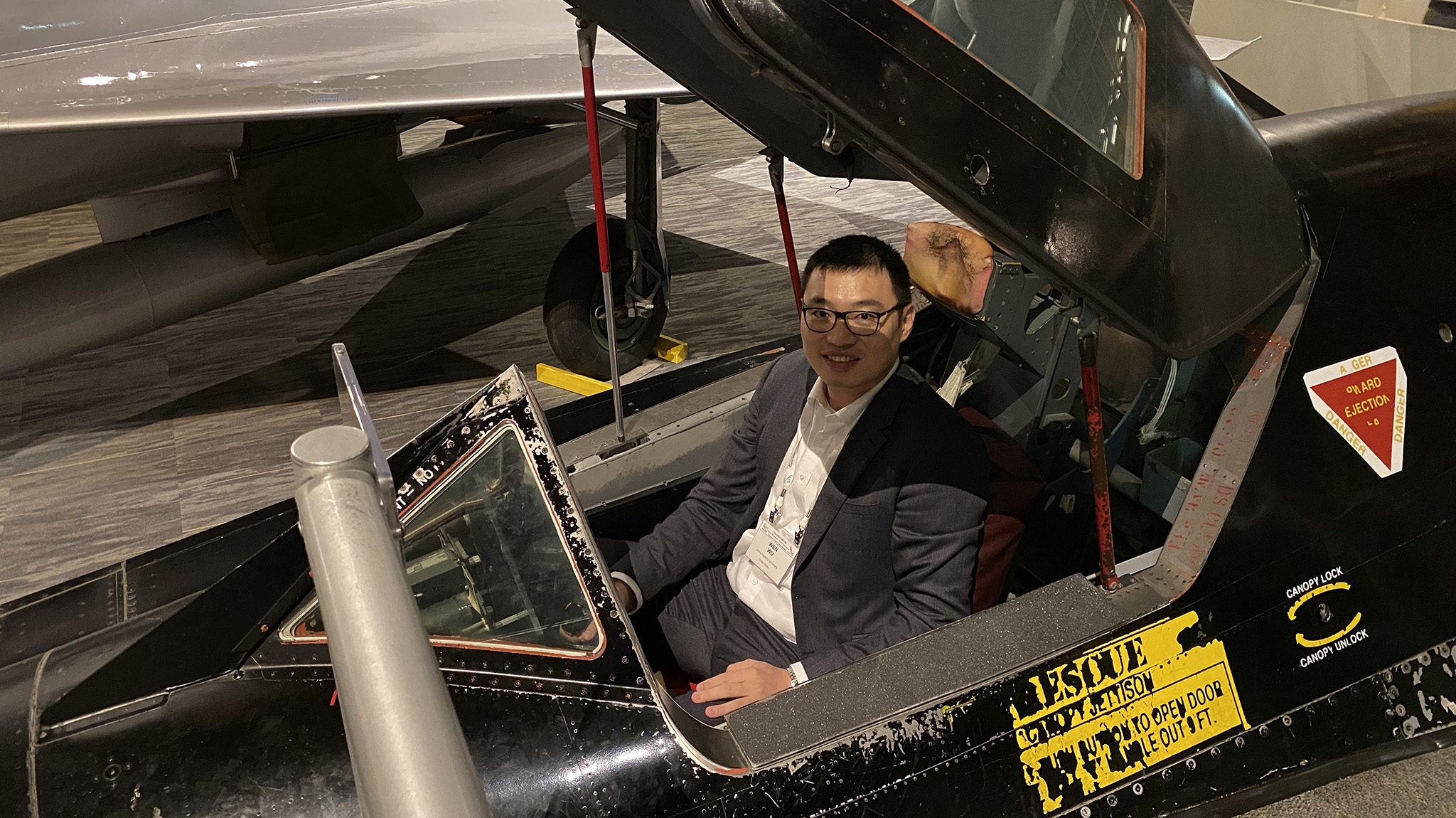
Wen Wu, assistant professor of mechanical engineering at the University of Mississippi, sits inside a showroom vehicle during the 2019 annual meeting of the American Physical Society, Division of Fluid Dynamics, in Seattle. Submitted photo
Anyone who has ever experienced turbulence while a passenger on an airline flight knows it can be disturbing. But the work of a University of Mississippi professor studying the effects of surface roughness and instability behind the unsteady aerodynamic loads may one day yield calmer and safer flights.
Wen Wu, who joined UM’s Department of Mechanical Engineering as an assistant professor in February, will be lecturing on fluid mechanics and aerodynamics in the coming fall semester. Wu also expects to teach other thermo fluids-related subjects, such as thermo fluids, propulsion and turbulence.
“When I asked Dr. Raj (Arunachalam Rajendran, chair and professor of mechanical engineering) why they looked particularly for someone focusing on the numerical study of turbulence, he explained to me the appreciation on the research about fundamental flow physics in the ME department, a consensus about the wide engineering applications and potential in getting funding of computational fluid dynamics,” Wu said.
“He also presented an explicit plan to grow the impact of the ME department and Ole Miss in this area. I was very impressed and decided that it is the institute that I want to be part of.”
Rajendran said Wu’s research achievements are expected to keep the university on the cutting edge in the field.
“Dr. Wu’s professional achievements include a series of fruitful investigations on flow detachment from its adjacent surface,” Rajendran said. “I think his work provides great insights from many perspectives to our current inadequate knowledge on a turbulent flow that is both among the most critical factors that affect the performance of thermo-fluid devices and the hardest ones for numerical tools to predict accurately.”
In his research, Wu uses “numerical integration” to find numerical approximations to the solutions of the partial differential equations governing turbulent motion.
“The turbulence in real life is so complex that the calculation requires supercomputers that have hundreds or thousands of CPUs,” Wu said. “This approach is called ‘high-fidelity computational fluid dynamics.’ It allows me to get close to the ‘real physics’ happening in turbulence and to utilize the rich statistical data to provide guidelines for future engineering techniques.”
Despite decades of research and application of airfoils in the aviation industry, many flow mechanisms related to flow separation are still unexplored, such as the presence of rain, insect deposits or ice that changes the surface finish and the separation-induced vibration of the airfoil. The recent Boeing 737 MAX tragedies are examples of failures in control flow separation due to the limited understanding of turbulence.
“The resolution used in my study is extremely fine – 500 million points are used just for a small region near the upper side of the wing near the leading edge,” Wu said. “It’s like running a ‘numerical experiment,’ where you reproduce the real behavior of a real wing, but you do it in a supercomputer.”
High-fidelity simulation techniques make available data with an accuracy that can never be measured in a real wing on aspects such as multipoint, unobtrusive measurements of velocity, velocity gradients, pressure, passive scalars and so forth. It is critical to apply the equations to the specific problems in the right way, and that is what Wu attempts to do.
Besides flow separation, Wu’s research has shed new light on various multiphysics turbulent flows, including the formation of dust clouds that blinds the pilot when a helicopter is hovering over sandy terrain, and the optimization of combustion in jet engines.
“Turbulence can be found almost everywhere in the world around us, and it can generate significant implications for everything within its grasp,” Wu said. “There are a lot of unknowns to explore.”
Wu said his short-term plan at the university includes setting up his research group and quickly turning several ideas into publications. Meanwhile, he will strive to secure some external funding and seek collaborations with other faculty members at Ole Miss and across the globe.
“For teaching, I will show how fascinating our discipline is to new populations of undergraduates, and offer the best intellectual, professional and social support to juniors and seniors to help them get ready for the job market,” Wu said.
Wu’s long-term goals are to build a reputation for being an active researcher and the leader of an internationally recognized research group in his field, to contribute significantly to the research on fluid dynamics in the department and to make this field a significant part of intellectual life at Ole Miss.
“I aim at being a pioneer of pedagogy to further improve and enhance the active learning experience of our students,” he said. “I will develop new courses to help the ME department and School of Engineering to increase enrollment and develop minor programs, such as aerospace engineering and energy engineering.”
Originally from China, Wu earned his Bachelor of Engineering degree from the University of Science and Technology of Beijing, his master’s degree from the University of Science and Technology of China and his Ph.D. at Queen’s University in Canada. In 2016, Wu did postdoctoral work at Queen’s University and Johns Hopkins University until he joined UM in February.
“The outstanding academic reputation of Ole Miss as the state’s flagship university and the high levels of excellence in academics and research were also important to my decision to work here,” Wu said. “I also appreciate the nice and brilliant people, the stunning campus and the vibrant college-town spirit.”
Wu and his wife, Jia, enjoy traveling, hiking, skiing, reading books and playing with their 8-year-old tabby cat, MooMoo.